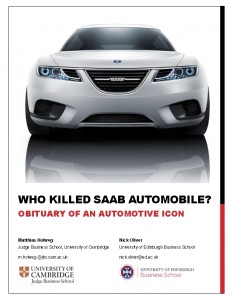This article originally appeared in the March 2012 Gryphon.
By Fred Hopper
During the dark d ays of December 2011 a report was published by a pair of academics from the UK just one day after the announcement of Saab’s bankruptcy. Who Killed SAAB Automobile? Obituary of an Automotive Icon was written by Matthias Holweg of the University of Cambridge Judge Business School and Nick Oliver of the University of Edinburgh Business School. It’s a scholarly and highly detailed look at the history of the company and the context in which it found itself facing bankruptcy.
ays of December 2011 a report was published by a pair of academics from the UK just one day after the announcement of Saab’s bankruptcy. Who Killed SAAB Automobile? Obituary of an Automotive Icon was written by Matthias Holweg of the University of Cambridge Judge Business School and Nick Oliver of the University of Edinburgh Business School. It’s a scholarly and highly detailed look at the history of the company and the context in which it found itself facing bankruptcy.
The paper starts with a two-page executive summary and I would recommend reading at least this if you don’t have the time to read the full 41-page report. There has been much criticism in the Saab community of General Motors throughout the entire time they have owned Saab, but particularly since their decision to sell Saab and their refusal to allow it to be sold to potential Chinese buyers, effectively forcing the company into bankruptcy. Common criticisms include assertions that GM did not understand Saab, they did not know how to effectively market it, that they diluted the uniqueness and therefore the distinctive appeal of Saab, and so on.
What is not so often explained is that the automotive industry has been undergoing tremendous change in the past few decades with globalization, increased competition and most significantly increased product complexity which makes it incredibly expensive and time consuming to develop new products. It now takes many years and millions of dollars to develop a new car model and many manufacturers are now able to share R&D and parts among families of cars under different marques. According to the report one of the key reasons for the failure of Saab is that did not have the economies of scale that it needed to survive in its current niche as, in the words of the authors, a “low volume producer of not-quite-premium cars.”
Although I personally would not agree with the “not-quite-premium” assessment, the comparisons made in the paper with companies such as the Volkswagen Group make for a compelling argument. In theory the Saab purchase held out much opportunity for both companies and to its credit GM spent (and lost) a substantial amount of money on Saab throughout the time of its ownership. Saab however resisted the level of integration needed with the other GM marques for what everyone in the Saab community will agree were “all the right reasons.” This reluctance to lower its standards to enable better integration with the parent company was also highlighted in the recent Top Gear tribute to Saab. Unfortunately this meant that GM was not able to integrate Saab into its product group the way Volkswagen was able to integrate Audi, for example.
Finally the story of Saab as a business is very well told in the paper. After reading Section II “A Brief History of Saab” I was amazed with how many facts about the company I actually knew, in part due to the serialized books that we have published in The Gryphon in the past on the company’s history. This brief history itself takes up 11 pages of the paper and does an excellent job of covering the company’s history and in particular the events of the two years under Spyker and Victor Muller.
Although the paper is written with all of the usual disciplines of academic research including a comparison of leading hypotheses with supporting evidence, references, etc., it is hard to escape the feeling that Matthias and Nick secretly care about the Saab marquee and that this project was a labour of love. Who Killed Saab Automobile is a must-read for all English-speaking Saab owners and enthusiasts.
Download the paper using the link below (or alternatively search on the paper’s title):

